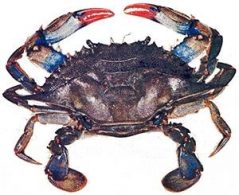

Harvesters may keep up to 10 gallons whole per day.įor updates on a possible early end to the closure, check . Minimum size is five (5) inches from spike to spike. There are no size limits on blue crab, though it is a recommended conservation measure to throw female blue crabs back unharmed. The Atlantic coastline will be tackled next year.

15, though it is possible the closure will end earlier if the cleanup goes quickly, according to Nalley.Īfter the waters along the western Panhandle are cleaned up, FWC will move down to the southern part of the state closing from Pasco to Broward counties from July 10-18, and then from the Hernando to Wakulla counties from July 20-29. Traps can be placed back in the water starting Jan. Traps attached to private property, such as a dock, may also remain in the water. Harvesting blue crabs through other methods, such as by dip nets or fold-up traps, is permitted during the closure. There are 13 active commercial blue crabbers licensed in Bay County, according to FWC data. The season typically runs from the end of June to late September. The closure is expected have the greatest impact on commercial blue crabbers. Florida scalloping is enjoyed by thousands of Floridians and tourists each year. Statewide, FWC removes about 5,000 derelict Spiny Lobster, Stone Crab and Blue Crab traps annually. Typically, under 100 traps are collected from Escambia to Franklin counties, according to Nalley. Some volunteer groups may also collect traps with FWC direction. “FWC observers are on board all commercial boats participating in trap retrieval operations” “FWC contracts with commercial fishers during the closed season to remove derelict traps,” Nalley said. The closures apply to both recreational and commercial crabbers.
#Blue crab season florida series#
They can “spark user conflicts, 'ghost fish' (continue to catch marine organisms until traps degrade enough to allow escape), visually pollute, may cause damage to sensitive habitats, and also become hazards to navigation.”Īfter fielding complaints from blue crabbers, in 2009 FWC created a series of short blue crab trapping closures around the state to allow time to clean out the waterways. Lost and abandoned traps are a nuisance, according to Amanda Nalley, a spokeswoman with Florida Fish and Wildlife Conservation Commission (FWC). Next day shipping is available by selecting UPS ground No additional payment needed for next day air delivery. The short trapping closure, which happens every other year, is expected to end Jan. My third best spot is located in Northeast Florida, on Amelia Island. The claws of adult females are usually tipped with red. They have olive to grayish-blue bodies and bright blue legs and claws. Recreational and commercial blue crab harvesting is allowed during this time, but there are certain regulations that need to be followed in order to ensure a sustainable blue crab population. More information regarding the FWC’s trap-retrieval program, blue crab trap closure dates, regulations and cleanup events is available online at /Marine by clicking on “Trap and Debris.” For additional information, contact the FWC’s trap retrieval coordinator, Pamela Gruver, at 85.PANAMA CITY - Owners of blue crab traps need to pull them from state waters from Franklin County to the Alabama line today to allow conservation officials to identify and remove abandoned traps. Blue Crabs: My Best Crabbing Spots in Florida. Blue crabs are the most popular species of crab to eat in Florida and live in almost all of Florida’s coastal waters. Blue crab season in Florida typically lasts from May through October. While state waters extend to nine nautical miles offshore in the Gulf of Mexico, the blue crab trap closures include only state waters extending to three nautical miles offshore on both coasts.
#Blue crab season florida license#
There are six regional closures total: three in even-numbered years on the east coast and three in odd-numbered years on the Gulf coast and in south Florida. Standard crab trap are as following, you can have 5 traps without commercial license in Florida. The closure is one of three regional, 10-day blue crab trap closures for 2021. They can also be unsightly in the marine environment, damage sensitive habitats and pose navigational hazards to boaters. Lost and abandoned blue crab traps are a problem in the blue crab fishery because they can continue to trap crabs and fish when left in the water. Closures may be reduced in duration if it is determined the number of lost and abandoned traps in the region will take less time to remove.


 0 kommentar(er)
0 kommentar(er)
